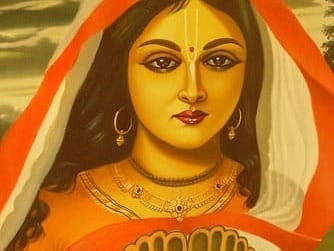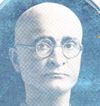Bhaktā Parameśvarī Śrī Viṣṇupriyā Devī

Question: Which tattvas would Śrī, Bhū, and Nīlā-śaktis be designated as? Who are they in Gaura-līlā?
Śrīla Prabhupāda’s answer: The Para-tattva-vastu, in His opulent manifestation as Nārāyaṇa has three potencies: Śrī, Bhū, and Nīlā. Kamalā, or Lakṣmī, is Śrī-śakti, Viṣṇu-bhakti is Bhū-śakti, and the sacred foundation or land that embraces Nārāyaṇa’s feet and is that upon which He roams is Nīlā-śakti; this is referred to as Durgā-śakti; she is the foundation of the world. These three śaktis are present within Gaura-nārāyaṇa. All the avatāras are present within the body of the avatārī (source of all incarnations), so by kaimutika-nyāya (argumentum a fortiori) ‘Nārāyaṇa-ness’ is present with Śrī Kṛṣṇa. Śrīman Mahāprabhu is Svayaṁ-rūpa Advaya-jñāna-tattva Vrajendra-nandana (the Original Personality of Godhead, the Nondual Truth, the son of the king of Vraja). Therefore, there is no scarcity of any tattva in Him. This is why Śrīla Ṭhākura Vṛndāvana has referred to Śrīman Mahāprabhu as ‘Kṣirodaśāyī’ Viṣṇu, which Śrīla Kavirāja Gosvāmi-prabhu has corroborated, showing that “the devotees’ words can never be wrong” and establishing that all tattvas are contained within Śrī Kṛṣṇa, the aṁśī (source).
The pastimes Śrī Gaurasundara displayed up until His journey to Gayā were manifestations of His Nārāyaṇa-līlā. In His gṛhastha pastimes, Śrīman Mahāprabhu manifested only His Nārāyaṇa form. Lakṣmī-priyā and Gaura’s gṛhastha pastimes must be understood to be the pastimes of Vaikuṇṭha’s Lakṣmī-Nārāyaṇa. In verse 43 of Gaura-gaṇoddeśa-dīpikā, Kavi-karṇapūra has said that he who was the monarch of Mithilā, King Janaka, is Vallabhācārya during Gaura’s incarnation. Lakṣmī-priyā is the daughter of that Vallabhācārya. Jānakī and Rukmiṇī combined to become his daughter named Lakṣmī.
Śrī Lakṣmī disappeared prior to Śrī Gaurasundara’s prema-bhakti-svarūpa manifesting. In other words, Viṣṇupriyā is prema-bhakti-svarūpiṇī (the embodiment of prema-bhakti). When she was growing up, Lakṣmī-priyā was present as Gaura-nārāyaṇa’s attendant. When that prema-bhakti gradually developed and became qualified for Śrī Gaurasundara’s service, then Śrī Lakṣmī-devī disappeared. By tattva considerations, Śrī Viṣṇupriyā-devī is the embodiment of Bhū-śakti. In Śrī Gaura-gaṇoddeśa-dīpikā, Kavi-karṇapūra has written that he who was previously King Satrājita has become known by the name ‘Sanātana Rāja-paṇḍita’ during Gaura’s incarnation. The embodiment of Bhū-śakti, Jagan-mātā (Mother of the World) Viṣṇupriyā is his daughter. In Śrī Caitanya-candrodaya-nāṭaka, Kavi-karṇapūra has referred to Śrī Viṣṇupriyā-devī as the expansion of Pṛthivī. Śrī Viṣṇupriyā-devī is Śrī Gaurasundara’s consort who aids Him in the task of preaching prema-bhakti. Śrī Gaurasundara is the combined form of Rādhā-Kṛṣṇa, therefore Jagan-mātā Viṣṇupriyā, who is Bhakta-vātsalya-vidhāyinī (the bestower of parental affection upon the devotees), can be said to be Rādhā-Kṛṣṇa’s sevikā. She can be referred to as Bhaktā Parameśvarī, the maidservant of Vṛṣabhānu-nandinī.
The form Śrī Gaurasundara manifested in Ādi-līlā, before going to Gayā, is His Nārāyaṇa form. He accepted Śrī Lakṣmī-priyā and Śrī Viṣṇupriyā as His lawfully wedded wives. Even after returning from Gayā, the pastimes He displayed had very much mixed moods; in other words, there was still a manifestation of opulence remaining. For example, He assumed a four-armed Nṛsiṁha form at Śrīvāsa’s house and manifested the form of Varāha at the house of Murāri Gupta, or sometimes sat on the throne of Viṣṇu. Towards the end of His pastimes in family life, He became overwhelmed with the moods of Rādhā and manifested the topics of Kṛṣṇa’s sweet pastimes to the world, though it is not as if He was not revealing the topics of Kṛṣṇa-līlā during the middle portion of His family life pastimes. After his return from Gayā, He was absorbed in the mood of the āśraya, despite being the original viṣaya, and had begun shouting “Gopī, gopī!” He ordered Ṭhākura Haridāsa and Nityānanda to perform kīrtana of kṛṣṇa-kathā from door to door throughout the world.
